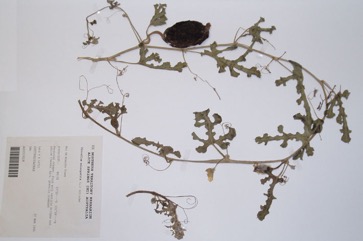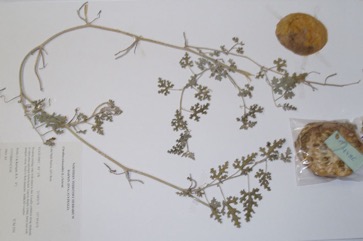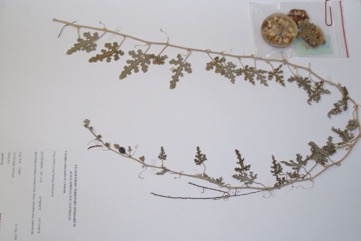Colocynth, Bitter Apple, Bitter Cucumber

A tropical plant. It is native to Tropical Africa. It grows in Mediterranean and warm temperate places. It grows on sandy soils, sand dunes and open plains. It is very drought tolerant. It produces best in dry, sunny periods. It grows in desert places. It can grow in arid places.
Also known as:
Andrian, Bitter Gourd, Desert squash, Egusi, Etipuchchha, Felitsikiry, Handhal, IHanzal, ndrak, Indranan Indrani, Indravana, Indrayan, Kaduvrindavana, Kaud tumbha, Kor tumma, Kwariowa, Kyi-ah, Mahendravaruni, Makal, Marghone, Murrah, Paparabudana, Payamekkekayi, Peykkumutti, Peykommutti, Pirpandyan, Shary, Sierra Leone Gourd, Tarha marha, Tastumba, Thaisim hagong, Tlang donkho, Toos, Trooh, Tumba, Tumma, umtikayi, Unuun, Verittumatti
Synonyms
- Colocynthis vulgaris Schrad.
- Cucumis colocynthis L.
- and others
Edible Portion
- Seeds, Fruit, Seeds - oil, Caution, Vegetable, Leaves
Where does Colocynth grow?
Found in: Afghanistan, Africa, Algeria, Arabia, Argentina, Asia, Australia, Africa, Bahrain, Benin, Burkina Faso, Canary Island, Cape Verde, Central Africa, Chad, Cyprus, Egypt, Ethiopia, Gabon, Gambia, Ghana, Greece, Guinea, Guinée, Himalayas, India, Indochina, Iran, Iraq, Israel, Italy, Kenya, Libya, Madagascar, Mali, Mauritania, Mediterranean, Morocco, Myanmar, Niger, Nigeria, North Africa, Northeastern India, Oman, Pakistan, Paraguay, Rotuma, Sahara, Saudi Arabia, SE Asia, Socotra, Senegal, Sikkim, Somalia, South America, South Sudan, Spain, Sri Lanka, Sudan, Tunisia, Turkmenistan, Vietnam, West Africa, Yemen
Notes: There are 3 Citrullus species.
Status: It is a famine food.
Growing Colocynth, Bitter Apple, Bitter Cucumber
Cultivation: It can be grown from seed or root segments.
Edible Uses: CAUTION: The fruit is poisonous if regularly eaten. The fruit requires long boiling to remove the bitter principle. The skin is pierced before boiling. The water is changed several times. The seeds are washed with salt water many times. They are also buried with salt in sand and kept covered there for a few weeks. They are then washed and ground and made into flour. The coating is removed. The seeds are also roasted. The seeds yield an edible oil. The fruit are pickled.
Production: In Sikkim fruit are available September to October.
Nutrition Info
per 100g edible portion| Edible Part | Energy (kcal) | Protein (g) | Iron (mg) | Vitamin A (ug) | Vitamin c (mg) | Zinc (mg) | % Water |
|---|---|---|---|---|---|---|---|
| Seed dried | 556 | 23.6 | - | - | - | - | 6.7 |
Colocynth, Bitter Apple, Bitter Cucumber Photos



References
Abbiw, D.K., 1990, Useful Plants of Ghana. West African uses of wild and cultivated plants. Intermediate Technology Publications and the Royal Botanic Gardens, Kew. p 40 (As Colocynthis vulgaris)
Akubundu, E. N. T., Cherry, J. P., & Simmons, J. G., 1982, Chemical, Functional, and Nutritional Properties of Egusi (Colocynthis citrullus L.) Seed Protein Products. Journal of Food Sci., 47, pp. 829–836.
Al-Snafi, A. E. (2016), Chemical constituents and pharmacological effects of Citrullus colocynthis - A review, IOSR Journal of Pharmacy, vol. 6, issue 3, pp. 57-64.
Ambasta, S.P. (Ed.), 2000, The Useful Plants of India. CSIR India. p 127
Ayantunde, A. A., et al, 2009, Uses of Local Plant Species by Agropastoralists in South-western Niger. Ethnobotany Research and Applications. Vol. 7: 53-66
BHANDARI,
Blamey, M and Grey-Wilson, C., 2005, Wild flowers of the Mediterranean. A & C Black London. p 148
Bodkin, F., 1991, Encyclopedia Botanica. Cornstalk publishing, p 261
Burkill, H. M., 1985, The useful plants of west tropical Africa, Vol. 1. Kew.
Burkill, I.H., 1966, A Dictionary of the Economic Products of the Malay Peninsula. Ministry of Agriculture and Cooperatives, Kuala Lumpur, Malaysia. Vol 1 (A-H) p 566
Cancilla, D., 2018, Ethnobotanical and Ethnozoological Values Desktop Assessment - Eliwana Project. p 10
Chettri, N. & Sharma, E., Non-timber Forest Produce: Utilization, Distribution and Status in the Khangchendzonga Biosphere Reserve, Sikkim, India.
Dalziel, J. M., 1937, The Useful plants of west tropical Africa. Crown Agents for the Colonies London.
Dansi, A., et al, 2008, Traditional leafy vegetables and their use in the Benin Republic. Genet Resour Crop Evol (2008) 55:1239–1256
Esquinas-Alcazar, et al, 1983, Genetic Resources of Cucurbitaceae. International Board of Plant Genetic Resources.
Facciola, S., 1998, Cornucopia 2: a Source Book of Edible Plants. Kampong Publications, p 84
Flora of Australia, Volume 8, Lecythidales to Batales, Australian Government Publishing Service, Canberra (1982) p 175
Flora of Pakistan. www.eFloras.org
Grubben, G. J. H. and Denton, O. A. (eds), 2004, Plant Resources of Tropical Africa 2. Vegetables. PROTA, Wageningen, Netherlands. p 560
GUPTA & KANODIA,
Hedrick, U.P., 1919, (Ed.), Sturtevant's edible plants of the world. p 194
Hiddins, L., 1999, Explore Wild Australia with the Bush Tucker Man. Penguin Books/ABC Books. p 157
Hussey, B.M.J., Keighery, G.J., Cousens, R.D., Dodd, J., Lloyd, S.G., 1997, Western Weeds. A guide to the weeds of Western Australia. Plant Protection Society of Western Australia. p 140
Huxley, A. (Ed.), 1977, The Encyclopedia of the Plant Kingdom. Chartweil Books. p 64
Igwenyi, I. O., Eze. C. A., Azoro, B. N., Offor, C. E. and Nwuke, C. P., 2011, Proximate, Mineral and Amino Acid Compositions of Irvingia gabonesis and Citrullus colocynthis Used as Soup Thickener in South Eastern Nigeria. International Journal of Biotechnology and Biochemistry. 7(4): pp. 493-498.
Jardin, C., 1970, List of Foods Used In Africa, FAO Nutrition Information Document Series No 2.p 41
Kiple, K.F. & Ornelas, K.C., (eds), 2000, The Cambridge World History of Food. CUP p 1770
Lamp, C & Collet F., 1989, Field Guide to Weeds in Australia. Inkata Press. p 79
Lazarides, M. & Hince, B., 1993, Handbook of Economic Plants of Australia, CSIRO. p 60
Linnaea 12:414. 1838
Lyle, S., 2006, Discovering fruit and nuts. Land Links. p 126
Majeed, M., et al, 2021, Gathered Wild Food Plants among Diverse Religious Groups in Jhelum District, Punjab, Pakistan. Foods 2021, 10, 594.
Medhi, P. & Borthakur, S. K., 2012, Phytoresources from North Cachur Hills of Assam -3: Edible plants sold at Hflong market. Indian Journal or Natural Products and Resources. 3(1) pp 84-109
Menninger, E.A., 1977, Edible Nuts of the World. Horticultural Books. Florida p 105 (As Colocynthis vulgaris)
Mertz, O., Lykke, A. M., and Reenberg, A., 2001, Importance and Seasonality of Vegetable Consumption and Marketing in Burkina Faso. Economic Botany, 55(2):276-289
MORTIMORE, (As Colocynthis vulgaris)
Okigbo, B.N., Vegetables in Tropical Africa, in Opena, R.T. & Kyomo, M.L., 1990, Vegetable Research and development in SADCC countries. Asian Vegetable Research and development Centre. Taiwan. p 38 (As Colocynthis vulgaris)
Paczkowska, G. & Chapman, A.R., 2000, The Western Australian Flora. A Descriptive Catalogue. Western Australian Herbarium. p 220
Peters, C. R., O'Brien, E. M., and Drummond, R.B., 1992, Edible Wild plants of Sub-saharan Africa. Kew. p 98
Pham-Hoang Ho, 1999, An Illustrated Flora of Vietnam. Nha Xuat Ban Tre. p 569
Phillips, D.C., 1988, Wild Flowers of Bahrain. A Field Guide to Herbs, Shrubs, and Trees. Privately published. p 105
POWER & MOORE,
Rajamanickam, E., Gurudeeban, S., Ramanathan, T. and Satyavani, K., 2010, Evaluation of anti-inflamatory activity of Citrullus colocynthis, International Journal of Current Research, Vol. 2, pp. 67-69.
Royal Botanic Gardens, Kew (1999). Survey of Economic Plants for Arid and Semi-Arid Lands (SEPASAL) database. Published on the Internet; http://www.rbgkew.org.uk/ceb/sepasal/internet [Accessed 15th April 2011]
SAXENA,
SHANKARNARAYAN & SAXENA,
Shekhawat, G.S. & Anand, S., 1984, An Ethnobotanical Profile of Indian Desert. J. Econ. Tax. Bot. Vol.5 No.3 pp 591-598
Sundriyal, M., et al, 2004, Dietary Use of Wild Plant Resources in the Sikkim Himalaya, India. Economic Botany 58(4) pp 626-638
Wheeler, J.R.(ed.), 1992, Flora of the Kimberley Region. CALM, Western Australian Herbarium, p 247
World Checklist of Useful Plant Species 2020. Royal Botanic Gardens, Kew
Zon, A.P.M. van der, Grubben, G.J.H., 1976, Les legumes-feuilles spontanes et cultives du Sud-Dahomey, Communication 65, Royal Tropical Institute, Amsterdam, p 50 (As Colocynthis vulgaris)